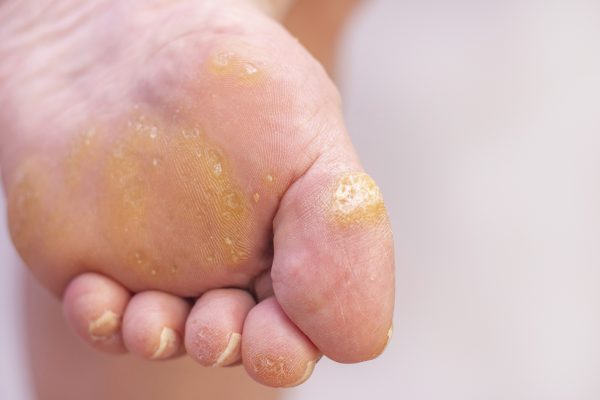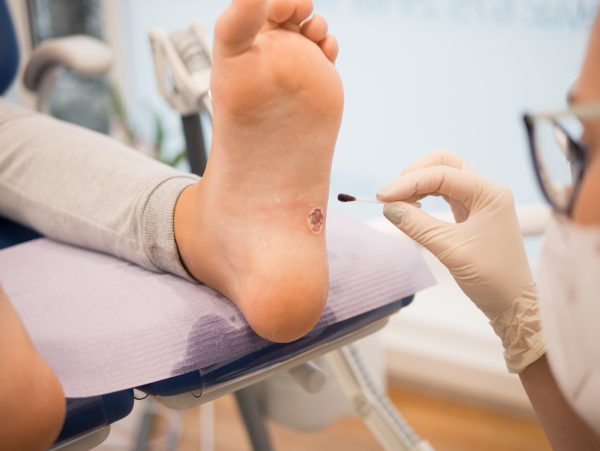You’ve had it up to here with unsightly warts popping up all over your feet. From bumps in between your toes to sores on your lower pads, these hard, grainy growths are not only ugly, they’re also painful! While foot (plantar) warts are technically not dangerous to your health, they rub in your shoes and are tender, making standing or walking miserable.
The good news is, plantar warts often go away on their own. The bad news is, without treatment, that can take a year or two!
To eliminate their discomfort or aesthetic distaste, many choose to remove or treat their plantar warts instead of letting them naturally run their course. In this post, we’re looking at some options for saying “bye bye” to foot warts, for good.
Before Removing a “Wart,” Properly Diagnosis
You have bumps or growths on your feet, but are you sure they’re warts? Plantar warts are often mistaken for corns or blisters, which can take a similar shape and cause similar discomfort.
Because warts can grow inward in the presence of calluses (see picture below), they can also be easily confused with other foot conditions.

All these conditions are treated differently, so before assuming it’s foot warts, read our Symptoms & Causes blog or seek a professional diagnosis.
Understand that Wart Removal Takes Time
If you’re sure it’s plantar warts, the next step is coming to terms with the treatment timeline.
Most methods for removing foot warts require several treatments, stretched over time. It’s not a “slice it off and move on” kind of situation. Foot wart treatments take several weeks or more to be effective, according to self-care advice given by The American Academy of Dermatology.
With this in mind, set the expectation that foot wart treatment is a long game. But when done right, it can foster long-term results— meaning, a lesser chance of recurrence.
Home Remedies for Plantar Warts
Many of our patients like to know their options for controlling their warts at home before seeking over-the-counter or professional removal options.
Two big at-home remedies for foot warts are tea tree oil and apple cider vinegar. While neither can be directly linked as an effective treatment over long-term trials, both have been studied for their healing properties.
Tea Tree Oil*
A now older 2008 study in the Complementary Therapies in Clinical Practice journal used tea tree oil to treat warts on a child’s finger. Because both foot (plantar) and hand (palmar) warts are caused by the human papillomavirus (HPV), the theory is that the treatment method would be relevant for either. After rubbing the oil on the warts once a day for 12 days, the area was completely healed.
Apple Cider Vinegar*
Another older 2006 study on the effects of apple cider vinegar looked at how “scattered reports suggest that the successive topical application of highly concentrated acetic acid solutions (up to 99%) alleviated warts… presumably due to the mechanical destruction of wart tissue.” Translation: the acids in the vinegar helped to break down the wart’s tissue. Using apple cider vinegar to treat foot warts is inconclusive, but for those interested in home remedies, it might be worth a shot!
*Before trying any at-home treatments for plantar warts, we highly recommend consulting your doctor, dermatologist, or foot care specialist. Without proper counsel, you could mistakenly damage your foot tissue. With oils, for instance, every brand is different. Some oils cannot be applied directly to the skin without diluting or being used with a carrier oil. This is just one example of why it’s important to do your research or get professional advice before self-treating warts.
Over-the-Counter Wart Treatments
There are a number of over-the-counter that you can get at your pharmacy without a prescription to self-treat foot warts.
Salicylic Acid Pads & Ointments
This type of acid is used commonly in acne treatments, wherein it breaks down dead skin cells. While you can purchase pads with the acid to place over a wart, most OTC wart creams help to shed the skin around your warts, gradually. They also are ideal for those with many warts, as it can be applied over a general area. In contrast, the pads need to be placed directly on the wart alone, since the acid can damage healthy skin with an acid “burn.”
Healthline recommends applying OTC wart ointment to your plantar warts twice a day. Remember, it could take several weeks before seeing results.
Freezing Sprays
Some opt for chilling sprays for a “quicker” turnaround time, sometimes eliminating foot warts in up to six weeks.
Freezing sprays work by applying a liquid nitrogen mixture over the wart, which creates a blister-like injury. Once your body naturally heals the blistered damage over the course of a week or so, the hope is that part of the wart will go away with it. This treatment is sometimes repeated a few times until the wart fully falls away.
Professional Wart Removal
Sometimes plantar warts can be persistent, holding up against home remedies or OTC treatments and requiring a professional touch.
In these cases, a doctor might use:
- Prescription-strength wart medications. These may be pads or ointments that your podiatrist must prescribe for extra potency. As we explained above, products with salicylic acid or liquid nitrogen can be extremely damaging to healthy skin, so follow your doctor’s orders when using these higher-strength treatments.
- Cryotherapy. This is much like the OTC freezing sprays mentioned above, except cryotherapy is performed by a trained professional. Wherein pharmacy sprays may only freeze your skin up to -70°C, cryotherapy often involves liquid nitrogen with a temperature of -196°C, according to Medical News Today. Overall, it’s a more effective treatment with a faster turnaround, but obviously with the additional price tag.
- Immune therapy. HPV attacks your immune system. Taking some medications to increase your immune system strength may help your body to fight off warts. A podiatrist can advise on immune support for the health of your feet and ankles.
- Surgical removal. A podiatrist may perform a minor “surgery” to remove your warts. Using an electric needle, the professional can cut them away, individually. Because this can be painful, your skin is often numbed for the procedure and there’s a risk of scarring, which is why it’s not a popular option.
- Laser treatment. Lasers can cauterize your vessels so that when the infected tissue falls off, your wart sheds with it. This usually takes multiple treatments, over the course of a few months. Like surgical removal, this can be painful and cause scarring, which is why it’s not a more common method for removing plantar warts.

Ready for Professional Removal?
If you’ve tried natural home remedies or over-the-counter solutions to treat your foot warts and they just won’t go away, it might be time for professional care.
A podiatrist can not only properly diagnose your condition and treat warts, but they can also counsel you on the best practices for keeping them away in the future. From not walking barefoot in communal spaces to avoiding pedicures where the salon does not properly disinfect tools or equipment, our team at Foot & Ankle has all the advice you need.
Explore our Plantar Warts services or call 239.936.5400 to book an appointment, today.
Categorized in: Blog
Comments are closed